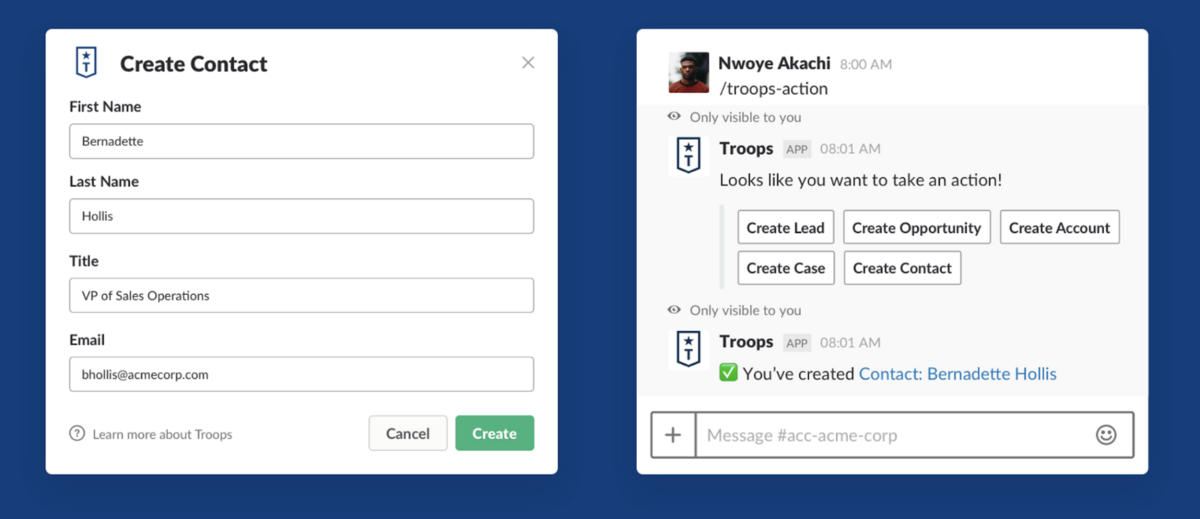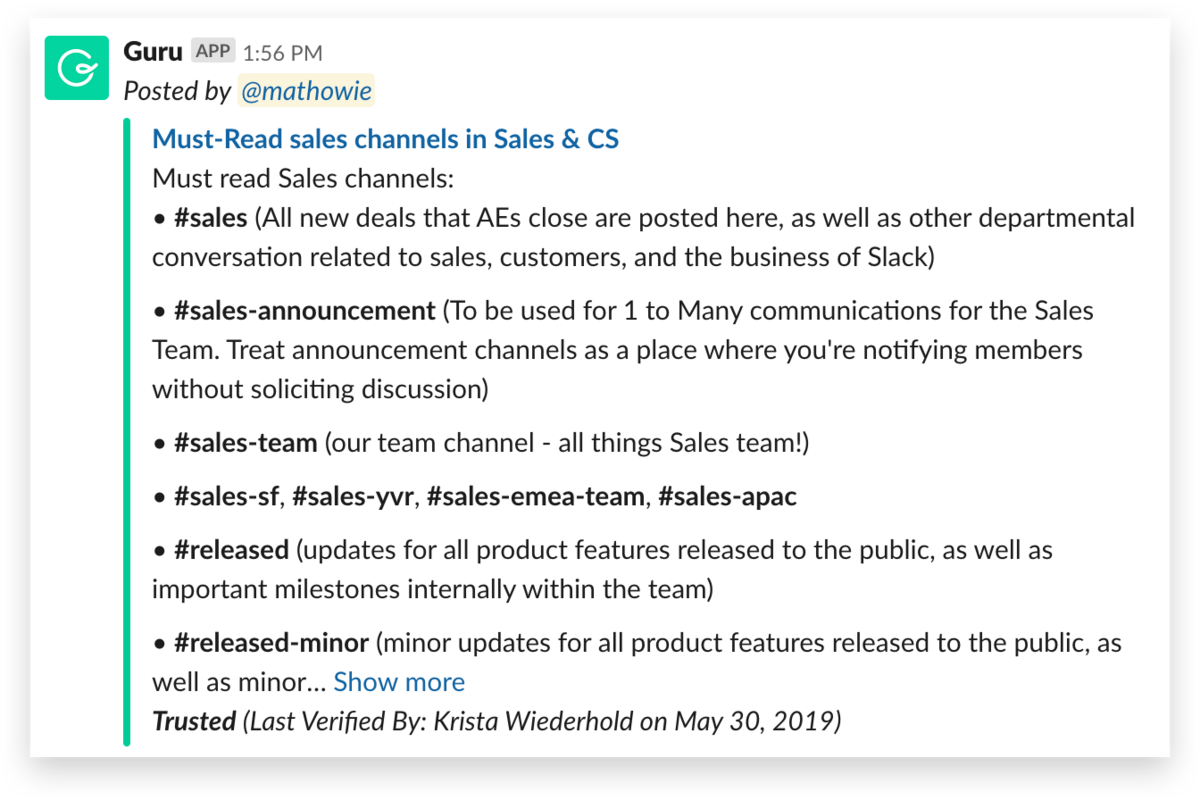Editor’s Note:
As you may have heard, Slack is now a part of Salesforce! This means some of the information below is dated, but we wanted to keep it around for historical context and other good reasons. For more details on Salesforce’s acquisition of Slack, read the official announcement.
Sales is a cyclical job. You engage potential buyers, build a business case, negotiate terms, and finally close the deal. If internal coordination bogs down during any step, all that work leading up to a deal can be for naught, and no team wants that.
That’s why good communication and agility are key to coordinating a large sales workforce like the one here at Slack. Of course, our sales team relies on Slack as the collaboration hub that pulls everything together—teammates, apps and data—to get their jobs done. So we interviewed a handful of sales staff at all levels to explore how they use Slack to serve current customers and prospects each day.
Using channels to organize everyday work
At Slack, every employee uses our Enterprise Grid product, which is designed for our largest customers. Teams in the thousands can use multiple workspaces, typically creating one for each major wing of the company. Sales & Customer Success makes up one of the nine workspaces in Slack’s own organization, and within that team’s workspace, channels have the following organization.
#account- channels: dedicated customer homes
Our sales team creates a channel for every major customer account, such as #account-lyft and #account-target. If you scroll back far enough in a channel’s history, it begins with early pre-sales details on the company’s size, the potential size of a deal, and any initial contacts. Later in the sales process, contracts are drafted and posted, any negotiations with the customer are noted, and deal approvals are reported in-channel.

Let’s say an exec needs to meet with a customer, or a new account manager takes over after the account grows into a new market segment. Any member of the sales team can join an account channel to see the full history of Slack’s interactions with that customer.
Over time, an account channel is rarely silent. Ongoing questions or problems from company contacts are shared here, along with periodic meeting notes and updates.
Coalescing in team channels
Every group of people working on the same topic at Slack coordinates in channels. Within the sales organization, you’ll find channels like #cs-ent-east-team, for those working in Customer Success for enterprise customers in the Eastern portion of America. A channel like #sales-emea-team is more general, where everyone from sales working with customers in Europe, the Middle East and Africa gathers to share news, announcements and discussions.
Org-wide sales channels: where we share wins and more
Sales team members don’t just talk among themselves; they also share major news in large channels that many in the company outside a sales focus follow. The main #sales channel is devoted to announcing significant new deals (shown below).

Each new message includes all the team members who helped take the deal over the finish line, a short description of how the customer started using the product, and stats on current number of seats (employees at the company who are signed up) and annual contract value. It’s a great place to not only learn about new customers but also congratulate sales team members for a job well done. Those kudos appear in threads and in ample emoji reactions on every message.
The #sales-announce channel is where upper management in sales can update the entire team with reminders of any weekly due dates, all-hands meetings, training opportunities, priorities for the quarter and offsite functions.
There are also fun channels, like #talesfromtheroad. Here, teammates shares photos, stories and insights when they return from customer visits. It helps the team stay connected, celebrate the work of others, and focus on what matters—our customers.
Channels to request help and close deals
There are a series of channels meant to offer support to sales staff at Slack, and they fall under a few naming conventions.
#help-channels are primarily for new hires to ask questions to more tenured members of the team, including clarification on processes and terminology.#plz-channels are where people post specific requests, essentially asking if someone could please help them complete a task new to them or beyond their training.#dsr-channels are a late-stage pre-sales tool that stands for “deal support request.” We spin up private#dsrchannels to share final contract details before signing up a new customer. Here, lawyers and sales staff share, edit and review documents, and deals are approved by our finance team and any necessary executives. Approvals that used to require a meeting with people from all over the company are now done in minutes using emoji reactions such as a check mark.
Troops: how we connect Salesforce and Slack
Like many other companies, Slack relies heavily on Salesforce to track customers and leads, along with the status and milestones of every deal already made or currently in progress. It’s the system of record for every contact point and every metric.
For many on the team, getting key information into and out of Salesforce without leaving Slack is ideal, and for that we use an additional app designed for Slack called Troops.

Troops acts as a conduit to Salesforce. It lets you query data by accounts, append notes to sales calls, and edit or modify contacts when anything changes. For most members of the sales team, it’s a way to speed up their work. You interact with a bot and tap a few buttons to update Salesforce data without having to switch windows or even leave a channel where discussions about customers are taking place.

Troops also offers a workflow builder, with a variety of options based on any number of criteria you set. Sales team members can use this to:
- Automatically post into
#accounts-channels when deals change status from pending to complete. - Create their own alerts based on customer accounts they represent. For example, if a customer suddenly adds 100 new seats to their plan, an account manager is notified immediately so they can reach out.
- Add notifications to Slack whenever you are attached to a new prospect. This way, you never miss a deal brewing and get warned whenever a lead grows stale following a set number of days since an update.
More sales tools for Slack
In addition to Salesforce and Troops, the Google Drive integration for Slack is key to moving the team’s day-to-day work forward, including sharing numbers in Sheets, presentations in Slides and notes in Docs. Meanwhile, Guru is the team’s knowledge base, using its app to create informational cards that can be easily shared, searched and linked throughout Slack.

The old standard, email, is also heavily in use by Slack’s sales team members, since they tend to work with outside companies, but we continue to use guest accounts and shared channels with customer teams whenever possible to keep communication open and real-time, and share them into channels using the Outlook and Gmail add-ons for Slack.
Lastly, our business technology team has created a slew of custom Slack apps that help streamline sales processes. These include:
- Ways to manage and customize notifications from various systems
- Approve/deny buttons for various request flows in Slack
- The ability to fill out request forms in Slack to make changes to deals that get reflected in Salesforce, nominate employees for awards, and request data for customers still considering a purchase
- Workflows that involve asking in multiple channels for approvers to review contracts (and update Salesforce every step of the way)
There’s even a quick and easy /accounts custom slash command that can pull up detailed info on any account in Salesforce. This shortcut is one of the most often used tools in sales and happens to be how the rest of the organization accesses Salesforce data.

A more transparent sales org
One of the biggest benefits of Slack for our own sales team is adding transparency. The entire team can share and access information about the life cycle of a customer in channels, rather than having that context siloed in email inboxes. New sales hires can scroll through channel histories for context before their first meetings and join already updated on a customer’s needs. They can also seek help when they’re stuck, and quickly find out who to connect with to move a deal forward.
For managers and directors in sales, the predictable layout of channels means they can review how account reps are doing across the organization, check on new deals or customers needing attention, and read a channel’s history relating to any approvals and decisions asked of them.
Meanwhile, announcements let everyone know when deals are completed, and alerts help save deals from falling through the cracks. That makes for a happier sales team and, in the end, happier customers too.






